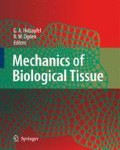Access this chapter
Tax calculation will be finalised at checkout
Purchases are for personal use only
Preview
Unable to display preview. Download preview PDF.
References
Abè, H., Hayashi, K., and Sato, M., eds. (1996). Data Book on Mechanical Properties of Living Cells, Tissues, and Organs. New York: Springer-Verlag.
Born, G. V. R., and Richardson, P. D. (1990). Mechanical properties of human atherosclerotic lesions. In Glagov, S., Newman, W. P., and Schaffer, S., eds., Pathologyof the Human Atherosclerotic Plaque. Proceedings of Workshop on the Evolution of the Human Atherosclerotic Plaque, 413–423. New York: Springer-Verlag.
Burleigh, M. C., Briggs, A. D., Lendon, C. L., Davies, M. J., Born, G. V. R., and Richardson, P. D. (1992). Collagen types I and III, collagen content, GAGs, and mechanical strength of human atherosclerotic plaque caps: spanwise variations. Atherosclerosis 96:71–81.
Canfield, T. R., and Dobrin, P. B. (1987). Static elastic properties of blood vessels. In Skalak, R., and Chien, S., eds., Handbook of Bioengineering. New York: McGraw-Hill.
Caro, C., Fitz-Gerald, J. M., and Schroter, R. C. (1969). Arterial wall shear and distribution of early atheroma in man. Nature 223:1159–1161.
Caro, C., Fitz-Gerald, J. M., and Schroter, R. C. (1971). Atheroma and wall shear. observations, correlation, and a proposal of a shear-dependent mass transfer mechanism for atherogenesis. Philos. Trans. R. Soc. Lond. B 177:109–159.
Davies, M. J., and Thomas, T. (1981). The pathological and microanatomy of occlusive thrombus formation in human coronary arteries. Philos. Trans. R. Soc. Lond. B 294:225–229.
Davies, M., and Thomas, A. (1985). Plaque fissuring — the cause of acute myocardial infarction, sudden death and crescendo angina. Br. Heart J. 53:363–373.
Davies, M. J., Richardson, P. D., Woolf, N., Katz, D. R., and Mann, J. (1993). Risk of thrombosis in human atherosclerotic plaques: role of extracellular lipid, macrophage, and smooth muscle cell content. Br. Heart J. 69:377–381.
Davies, M. J. (1998). Atlas of Coronary Artery Disease. Philadelphia: Lippincott-Raven.
Dobrin, P. B., and Rovick, A. A. (1969). Influence of vascular smooth muscle on contractile mechanics and elasticity of arteries. Am. J. Physiol. 217:1644–1651.
Dobrin, P. B. (1973). Isometric and isobaric contraction of carotid arterial smooth muscle. Am. J. Physiol. 225:659–663.
Falk, E. (1983). Plaque rupture with severe pre-existing stenosis precipitating coronary thrombosis. Characteristics of coronary atherosclerotic plaque underlying fatal occlusive thrombi. Br. Heart J. 50:127–134.
Freund, L. B. (1989). Dynamic fracture mechanics. Cambridge, UK: Cambridge Univ. Press.
Greenleaf, J. F., Fatemi, M., and Insana, M. (2003). Selected methods for imaging elastic properties of biological tissues. Ann. Rev. Biomed. Eng. 5:57–78.
Holzapfel, G. A., Sommer, G., and Regitnig, P. (2004). Anisotropic mechanical properties of tissue components in human atherosclerotic plaques. J. Biomech. Eng. 126:657–665.
Jones, C. B., Sane, D. C., and Herrington, D. M. (2003). Matrix metalloproteinases: A review of their structure and role in acute coronary syndrome. Cardiovasc. Res. 59:812–823.
Keeny, S. M., and Richardson, P. D. (1987). Stress analysis of atherosclerotic arteries. Proc Ninth Annual Conf, Engineering in Medicine and Biology Soc. IEEE 3:1484–5.
Lendon, C. L., Davies, M. J., Born, G. V. R., and Richardson, P. D. (1991). Atherosclerotic plaque caps are locally weakened when macrophages density is increased. Atherosclerosis 87:87–90.
Lendon, C. L., Davies, M. J., Richardson, P. D., and Born, G. V. R. (1993). Testing of small connective tissue specimens for the determination of the mechanical behaviour of atherosclerotic plaques. J. Biomed. Engr. 15: 27–33.
Regnier, C. H., Kolsky, H., Richardson, P. D., Ghoniem, G. M., and Susset, J. G. (1983). The elastic behavior of the urinary bladder for large deformations. J. Biomech. 16:915–922.
Richardson, P. D., and Keeny, S. M. (1989). Anisotropy of human coronary artery intima. Proc 15th Ann NorthEast Bioengineering Conference. 205–206.
Richardson, P. D., Davies, M. J., and Born, G. V. R. (1989). Influence of plaque configuration and stress distribution on fissuring of coronary atherosclerotic plaques. plaques. Lancet 2(8669):941–944.
Richardson, P. D. (2002). Biomechanics of plaque rupture: progress, problems, and new frontiers. Ann. Biomed. Eng. 30:524–536.
Sacks, M. S., and Sun, W. (2003). Multiaxial mechanical behavior of biological materials. Ann. Rev. Biomed. Eng. 5:251–284.
Schaar, J. A., Regar, E., Mastik, F., McFadden, E. P., Saia, F., Disco, C., de Korte, C. L., de Feyter, P. J., van der Steen, A. F. W., and Serruys, P. W. (2004). Incidence of high-strain patterns in human coronary arteries-Assessment with three-dimensional intravascular palpography and correlation with clinical presentation. Circulation 109:2716–2719.
Tanaka, A., Kawarabayashi, T., Fukuda, D., Nishibori, Y., Sakamoto, T., Nishida, Y., Shimada, K., and Yoshikawa, J. (2004). Circadian variation of plaque rupture in acute myocardial infarction. Am. J. Cardiol. 93:1–5.
Texon, M., Imparato, A. M., Lord, J. W., and Helpern, M. (1962). Experimental production of arterial lesions. AMA Arch. Intern. Med. 110:50–52.
Texon, M. (1957). A hemodynamic concept of atherosclerosis, with particular reference to coronary occlusion. AMA Arch. Intern. Med. 99:418–427.
Texon, M. (1980). Hemodynamic Basis of Atherosclerosis. Washington DC: Hemisphere Publ. Corp.
Williams, J. G. (1980). Stress analysis of polymers. Chichester: Ellis Horwood, 2nd edition.
Woolf, N. (1982). Pathologyof Atherosclerosis. London: Butterworth Scientific.
Author information
Authors and Affiliations
Editor information
Editors and Affiliations
Rights and permissions
Copyright information
© 2006 Springer-Verlag Berlin Heidelberg
About this chapter
Cite this chapter
Richardson, P.D. (2006). Mechanical Properties of Atherosclerotic Tissues. In: Holzapfel, G.A., Ogden, R.W. (eds) Mechanics of Biological Tissue. Springer, Berlin, Heidelberg. https://doi.org/10.1007/3-540-31184-X_15
Download citation
DOI: https://doi.org/10.1007/3-540-31184-X_15
Publisher Name: Springer, Berlin, Heidelberg
Print ISBN: 978-3-540-25194-1
Online ISBN: 978-3-540-31184-3
eBook Packages: EngineeringEngineering (R0)

